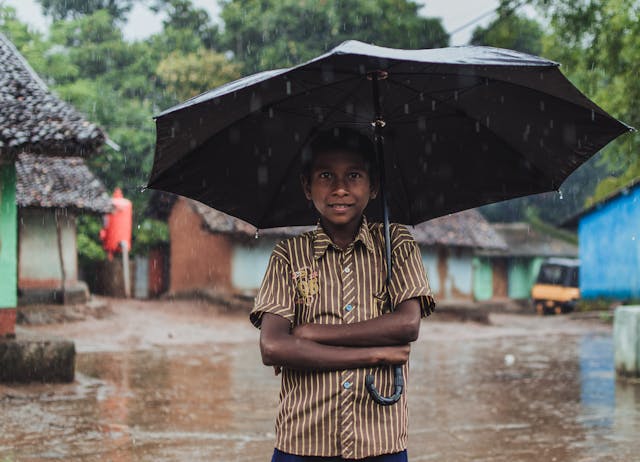
What causes the monsoon? The monsoons are caused by a wind change between the seasons.
When we picture a monsoon, many of us think of the monsoon season that comes to India every year, but India isn’t the only country to get a monsoon. Monsoons occur across most of Southern Asia and Northern Australia. Across large parts of Africa. And across the band from the northern part of South America to the southern part of North America.
The word monsoon was used in India to refer to the seasonal rains there, but it is not an Indian word and it was not used for rain until about 1580. The word started out as “wasama”, which is an Arabic word that means “to be marked”. That word became “mawsim”, that meant “time of year” and was used for festivals or anything that happens every year. Portuguese sailors heard Arabic sailors use it to refer to the rains on the Indian Ocean and they thought it referred to the rains. In Portuguese it became “moncao”, which became “monssoen” in Dutch. The Portuguese and the Dutch both had big trading ports in India and when the British arrived, the word was used by these groups of people to refer exclusively to the seasonal winds in India. That is where the British picked it up and it became “monsoon” in English.
So, what causes a monsoon? A monsoon is a period of heavy rain that is caused when the temperature of the land and the sea change, reversing the direction of the wind. In India, there are monsoons in both the summer and the winter, but the summer monsoon carries more rain and is the more famous of the two. Winds always blow from cold areas to warm areas because of the air pressure. When air is heated up, the molecules spread out more, making the air less dense and lowering its pressure. Air rushes in to fill those gaps, which is why wind blows from high pressure (cold) areas to low pressure (hot) areas. The difference between regular wind and monsoon winds is the amount of water they carry.
In the winter, the land is colder than the ocean and the wind travels from the land out to sea. The air picks up water over the sea, rises up into the air, and drops the water as rain when it gets too high and cools to the point where it can’t hold the water anymore. Once the rain has fallen over the sea, the dry air heads into land, where it cools down and sinks. The cycle repeats with the rain falling over the sea and dry air coming in to land. Then, when the winter ends and the summer starts, the land gets heated up and becomes hotter than the sea. This reverses the process. The land becomes hotter than the sea because the sea can dissipate heat more easily through its body than land can. The sea tends to stay a consistent temperature, while the land can heat up very quickly and cool down very quickly. When the land heats up in the summer, cool air comes down over the sea and picks up moisture. This moisture laden air blows into the land because wind blows from cold places to hot places. Once it is over the hot ground, the hot air rises until it is too cool to hold any water, and the water falls as rain. The monsoon season lasts for as long as the land is hotter than the sea, and then it reverses again.
If you take a vacation by the beach, you can experience the land heating up and cooling down more quickly than the sea. During the day, the sunlight heats the land and the sea, but the sea dissipates the heat, while the land keeps the heat at the surface and heats up quickly. This means the wind moves from the sea to the land. When the sun goes down, the land cools down quickly because there is no longer a direct heat source, but the sea contains the heat it picked up through the day and doesn’t cool down as much. This makes the sea warmer than the land and the wind blows off the land and out to sea. If you spend a day on the beach, you will feel the wind come off the sea through the day and back out to sea at night.
Monsoons can be both a blessing and a curse. The people that live in areas that have monsoons rely heavily on them to irrigate crops. There is not much infrastructure for irrigation systems and the monsoon provides water for the crops and for people. It also provides electricity through hydroelectric power plants. However, that means that all of the things that rely on the monsoon are seasonal. Drought can be on the flipside of monsoons because a large percentage of the year’s rainfall falls in those few months and there is little else through the rest of the year. It is also a curse because sometimes the rain is so heavy that the floods cause death and destruction. Because of climate change, the timing and the length of the monsoons are changing as well. And this is what I learned today.
Photo by Parij Photography: https://www.pexels.com/photo/boy-holding-black-umbrella-1483142/
Sources
https://education.nationalgeographic.org/resource/monsoon
https://scijinks.gov/what-is-a-monsoon
